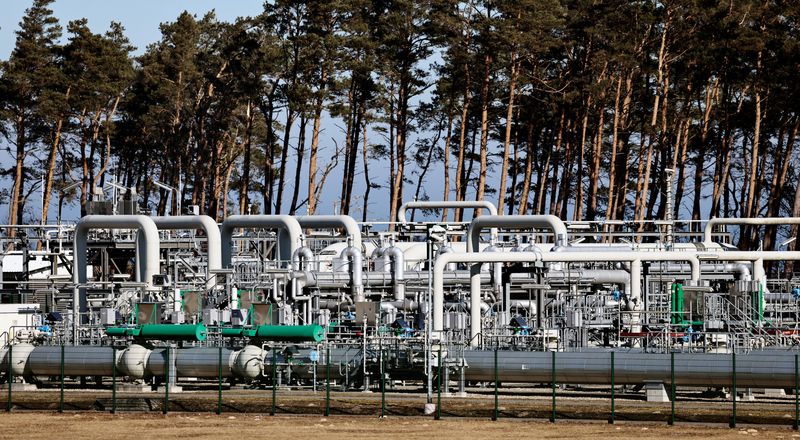By Nina Chestney
(Reuters) – Russian gas flows to Europe have fallen short of demand again, coinciding with an early heat wave gripping its south and fuelling concerns the continent may struggle to build up storage ahead of the winter season.
This follows Ukraine halting a gas transit route to Europe on last month, blaming interference by occupying Russian forces, and several European countries being cut off from Russian gas supply completely due to their non-compliance with a new payment mechanism.
The following outlines Europe’s options.
WHAT ARE THE KEY ROUTES FOR RUSSIAN GAS TO EUROPE?
Russia supplies about 40% of Europe’s natural gas, mostly by pipeline. Deliveries last year were around 155 billion cubic metres (bcm).
The Ukraine transit corridor mostly sends gas to Austria, Italy, Slovakia and other east European states.
Ukraine last month closed the key Sokhranovka transit pipeline that runs through Russian occupied territory in the east of the country.
European countries have been seeking to cut their reliance on Russian gas. Some have already been cut off from Russian supplies, after rejecting a Russian demand for a new payment method. But others, including Germany, still need Russian gas and are trying to refill depleted gas reserves.
Alternative routes to Europe which do not go via Ukraine include the Yamal-Europe pipeline, which crosses Belarus and Poland to Germany, and Nord Stream 1, which runs under the Baltic Sea to Germany.
The Yamal-Europe pipeline has a 33 billion cubic metre (bcm) capacity, around a sixth of Russian gas exports to Europe. Gas has been flowing eastward through the pipeline from Germany to Poland for some time.
Moscow has placed sanctions on the owner of the Polish part of the Yamal-Europe pipeline that carries Russian gas to Europe. However, Poland can manage without reverse gas flow on the Yamal pipeline, its climate minister has said.
Austria, Italy, Slovakia, the Czech Republic and Germany are receiving lower volumes through Nord Stream 1, which accounts for around 40% of Russian pipeline flows to the EU.
France reported it had received no Russian gas from Germany since June 15.
The Kremlin has said the supply cuts were not premeditated, blaming Western sanctions for a delay in return of equipment sent for maintenance to Canada.
Nord Stream 1 will also undergo a full annual shutdown from July 11-21.
WHERE ELSE CAN EUROPE GET GAS?
Some countries have alternative supply options and Europe’s gas network is linked up so supplies can be shared, although the global gas market was tight even before the Ukraine crisis.
Germany, Europe’s biggest consumer of Russian gas which has halted certification of the new Nord Stream 2 gas pipeline from Russia because of the Ukraine war, could import gas from Britain, Denmark, Norway and the Netherlands via pipelines.
Norway, Europe’s second biggest exporter behind Russia, has been pushing up production to help the European Union towards it target of ending reliance on Russian fossil fuels by 2027.
Britain’s Centrica has signed a deal with Norway’s Equinor for extra gas supplies to the United Kingdom for the next three winters. Britain does not rely on Russian gas and can also export to Europe via pipelines.
Southern Europe can receive Azeri gas via the Trans Adriatic Pipeline to Italy and the Trans-Anatolian Natural Gas Pipeline (TANAP) through Turkey.
The United States has said it can supply 15 bcm of liquefied natural gas (LNG) to the European Union this year.
U.S. LNG plants are producing at full capacity and a blast last week at a major LNG export terminal in Texas will keep it idle until September and it will operate only partially from then until the end of 2022.
Europe’s LNG terminals also have limited capacity for extra imports, although some European countries say they are seeking ways to expand imports and storage.
Germany is among the countries that want to build new LNG terminals. It plans to build two in just two years.
Poland, which meets about 50% of its gas consumption with Russian gas or around 10 bcm, has said it can source gas via two links with Germany.
In October, a pipeline allowing up to 10 bcm of gas per year to flow between Poland and Norway will be opened.
ARE THERE OTHER OPTIONS TO COPE WITH A GAS SUPPLY CRUNCH?
Several nations could seek to fill any gap in energy supplies by turning to electricity imports via interconnectors from their neighbours or by boosting power generation from nuclear, renewables, hydropower or coal.
Nuclear availability is falling in Belgium, Britain, France and Germany with plants facing outages as they age, are decommissioned or phased out.
Europe has been trying to shift from coal to meet climate targets but some coal plants have been switched back on since mid-2021 because of surging gas prices.
German officials are also preparing for any sudden halt in Russian gas supplies with an emergency package that could include taking control of critical firms, three people familiar with the matter told Reuters.
The gas supply situation is “tense” but German gas supplies are stable at the moment, Germany’s energy regulator the Bundesnetzagentur said on Friday.
Italy, meanwhile, could declare a state of alert on gas next week if Russia continues to curb gas supplies, two government sources said, which would be aimed at reducing gas consumption, rationing gas to industrial users and ramping up coal power generation.
(Reporting by Nina Chestney; Editing by xx)
